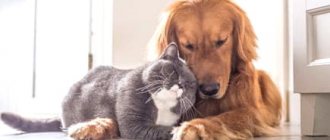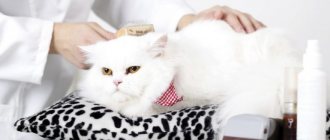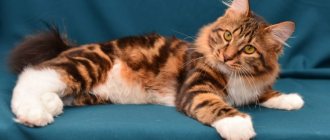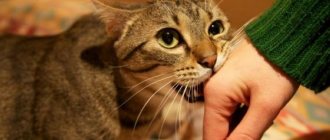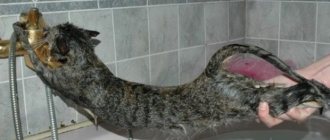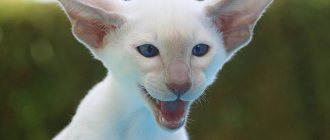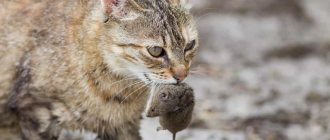Top 10 Friendliest Dogs
Surprisingly, but true: the kindest and most flexible dogs, according to experts, are not small, but large breeds. A toy terrier or a chihuahua, themselves the size of a cat, is quite distrustful of representatives of other species of animals, unless you take a kitten and a puppy at the same time and raise them together. But children's games will end sooner or later, and at best the animals will remain neutral towards each other.
And among the friendliest dogs were:
Poodle
Poodles have a reputation for being very intelligent and affectionate dogs, making them extremely popular as apartment pets. They also have a wide selection of colors and sizes: from a toy poodle (height only 25 cm) to a large poodle (60 cm at the withers).
Poodle. Photo; Living in Monrovia These dogs are not prone to heavy shedding and do not have a specific odor, but require periodic grooming and bathing.
Golden retriever
Representatives of this breed are not just royally beautiful - they are distinguished by sociability and devotion to their owner and all members of his family. Patient and kind dogs are generally not characterized by aggression; they get along well with adults and children, as well as with other animals.
The Golden Retriever does not perceive a cat as an enemy; on the contrary, if the animals grow up together, you can enjoy watching their fun games together. Well, it’s not for nothing that they say that retrievers are very smart - they understand that they cannot offend small ones!
Pug
Pugs have a very friendly character. They are able to make friends with anyone, and cats are no exception. They weigh much more than previous breeds, their weight can reach up to 8 kilograms. It won't scare the cat. But you definitely need to pay attention to the dog. Then the animal will remain docile and kind. Otherwise, the pug will try to attract the attention of its owners, and no one knows in what way. Perhaps he will begin to offend the cat, which takes all the attention for itself. If the animals find a common language, the cat's life will become much more fun. But in joint games there is a risk that the cat will injure the dog’s eyes. In pugs they are convex.
Bichon Frize
These snow-white miniature dogs resemble fluffy buns. Their docile nature is evidenced by the fact that representatives of the decorative breed were very fond of the European nobility. The dogs allowed themselves to be cut and curled, their fur decorated with ribbons and jewelry, and doused with perfume. And the dogs endured all this, while remaining optimistic.
This is a family-type breed - Bichons enjoy playing with children and other pets, maintaining mobility and activity even in old age. They are sincerely friendly not only with cats, but also with dogs much larger than themselves - there is no aggression or swagger in Bichons at all.
Which wool is “more invisible” in an apartment?
The coat of any pet should be well-groomed and healthy. Experienced breeders know that soft undercoat is collected from carpet and upholstered furniture much more easily than thin “needles” of hair from a pug or dachshund.
To ensure that the apartment is always clean, it is necessary to carry out regular cleaning twice a week. A healthy dog has less hair loss.
Laikas, Caucasian Shepherds, and Huskies shed constantly. For a small apartment this will be a real disaster, so it is best to avoid these breeds.
Small dogs are preferable in this regard. They are easier to care for - bathing and brushing a lapdog is much easier than combing a St. Bernard. The pet should be accustomed to a comb, as well as to water, from a very early age.
Absolutely non-shedding breeds include
- Yorkies;
- bichons;
- Chinese Crested Powder Powder.
If such a dog gets sick or is fed the wrong food, he may have problems with hair loss.
Wire-haired dogs have hair that needs to be plucked. The procedure is called trimming. It is carried out regularly, as hair loss does not occur on its own. To pluck hair correctly and painlessly, you will have to gain considerable experience. Some owners prefer constant trimming rather than paring or combing out mats.
Hairless, short-haired, smooth-haired breeds are better suited for a family with a child who suffers from allergic reactions and often suffers from respiratory diseases.
Labrador Retriever
The dog is ready to be friends with the whole world! If she opened her own account on social networks, her friends would include not only the owner and all family members, young and old, but also neighbors, the postman who brought the telegram, and even cats and rabbits! Moreover, not only their own, but also neighbors, street dogs, and even those who ended up in the same line with a Labrador at the veterinary clinic.
Labrador will make even the saddest pessimist look at life with a positive outlook. If there is a Labrador Retriever in the house, there are no quarrels. A dog brings an atmosphere of comfort and warmth into the house. And a cat lying in an embrace with a dog is not nonsense, this is sincere friendship between animals.
Breeds to Avoid
It is preferable to choose calm and not too active breeds rather than dogs with high activity and pronounced hunting instincts. For example, terriers are annoying, impudent, angry and very energetic. They were bred primarily to hunt and kill small fur-bearing animals. Most of them retain this instinct, directing it towards small domestic animals, which include cats. Herding breeds cannot resist “herding” all family members. Cats are unlikely to enjoy being chased by an enthusiastic dog.
Papillon
The miniature decorative dog has a playful character. The Papillon feels “universal love” both for people of any age and for pets. Are there other dogs? Shall we play? Cat? Why not a playmate?
Once upon a time, this breed of dog was bred specifically for members of the nobility. She is always happy, easily tolerates changes in surroundings, and sees cats not as enemies, but only as friends.
Cavalier King Charles Spaniel
Do you want to have a super-perfect dog at home? Then get a Cavalier King Charles Spaniel. A reliable companion, loyal to his owners to the point of puppy squeals - this is exactly him, the owner of a long, proud name. King Charles gets along well with children and animals; he will never offend a cat, even if it encroaches on the most sacred things - his bowl and bed.
A companion dog, a cheerful fidget with the kindest soul and expressive appearance, he will become an idol for both children and adults. Even the laziest cat will open one eye slightly if the dog walks past with a playful gait.
Maltese
Character - Nordic... No, clearly not Nordic. You will not find a kinder soul, there is no kinder dog in the whole world. Are you afraid that you won't make friends with your cat? Well, if only the cat himself bullies the dog. And the lapdogs themselves have a gentle and soft character, which is why they are considered one of the best family breeds.
Small dogs with snow-white fur enjoy every day; they are born optimists and faithful companions. Since ancient times, dogs of this breed have been considered good rat catchers. Can you imagine what will happen if, together with a cat, they start hunting small rodents?
Have you tried to seriously look at this cute face? How long did you last without smiling? But pugs are loved not only for their charming appearance.
Dogs have a friendly disposition and don’t mind sharing their favorite bed with someone else. Does the owner have his own bed? Well, then he’ll move and make room for the cat. However, not for free. Pugs are prone to obesity, and owners have to make sure that the pet does not overeat. But there is a rich treat - a cat's bowl. He doesn't mind sharing, does he?
Pomeranian Spitz
The Spitz is an energetic and attractive toy dog. Most Spitz dogs are smaller than cats due to their light weight. Thanks to this, cats do not have to fear these furry creatures, which are friendly with all animals.
Breed overview:
- Height: from 15 to 18 cm;
- Weight: from 1.3 to 3.5 kg;
- Physical Characteristics: Miniature in size with double-layered long coat; a fox face with pointed, protruding ears; fluffy tail curled up.
Pugs are adorable and happy little ones that get along with almost everyone. Most pugs are not in the habit of chasing people. Therefore, cats can rest assured that they will not be disturbed. The key to a peaceful existence is proper acquaintance. A cat and a pug will keep each other company when people are not at home.
Breed overview:
- Height: from 25 to 33 cm;
- Weight: from 6.3 to 8 kg;
- Physical characteristics: small round body, round head with many folds, short nose and donut curled tail.
Basset Hound
Like any cat, the basset loves the comfort of home. But this is not a cat, but a dog, especially a hound. For some reason, dogs of this breed are considered lazy - probably the appearance of the animal is misleading. But basset dogs are very affectionate and loyal, they love communication. They are full of energy, and all this, coupled with sad eyes on an overly important face, makes even the most stern and serious person smile.
However, the reputation of a lazy dog needs to be justified, so Bassets... are simply too lazy to walk, much less run after cats. But - “Cats are not a hindrance to happiness!”
Sheltie
These animals are loyal and intelligent. By nature they are not hunters, but shepherds. Therefore, a Sheltie will definitely not hunt for a cat. A dog can gain up to 12 kilograms of weight. Of course, cats are also different. Shelties are easy to train, sociable and responsive. If the owner teaches the dog to be friends with the cat, then he will never have problems with animals. Although no, one problem will still remain. Shelties love to chase cats. They can create a mess in the apartment or knock down their household members. But they won’t let either each other or their owners get bored.
German boxer
You give a new slogan: not “Cats against dogs,” but “Cat + dog = friendship.” And why not, if there is a German boxer living in the house?
Their owners can tell many different stories about the tender friendship and joint games of cats and dogs. St. Bernards, Alabais, and other dogs get along well with cats, and even fighting staffs can be raised so that they live peacefully with independent and proud cats, so a lot depends on the owner.
Each pet should have its own bowl, bed and toys. Affections and treats should be shared equally (just each has his own). Both need to be educated and trained. If a puppy appeared in the house already when a cat lives in it, you should gradually accustom them to each other - first by bringing them into the room on a leash, observing the behavior of the animals. Then this time needs to be increased, and when the animals get used to each other, you can leave them together.
Source
What dogs get along and are friends with cats?
Dogs who love cats are not uncommon. In many homes and even apartments, two opposites get along well - a cat and a dog. These natural adversaries can become friends with the right approach. Much depends on upbringing and on the correct selection of the dog breed: it should be friendly towards cats. There are many wonderful breeds that will not offend your tailed pet, but will keep him in pleasant company. Thanks to the correct selection of the breed, you can proudly say that a dog and a cat in the house are happiness. So which dogs like cats?
The main rule when choosing a companion for a cat: the dog should not be aggressive. In addition, it is not always possible for hunting dogs to find a common language with a cat, because their hunter instinct may kick in. However, this often happens to other people's cats, not to their own. However, the owner will have to work with the hunters so that at first, when the animals are still unfamiliar, no mishaps occur.
Another criterion: adult dogs should be approximately equal in size. Otherwise, even if she is friendly towards the cat, a situation may arise, for example in a game, when the animal accidentally damages something to a smaller pet. There are, of course, large dogs that are very careful when playing with kids. But still, the chances that the cat will remain safe and sound are greater with representatives of small breeds.
However, it is worth considering that even with docile dogs, a cat may not get along. The reason for this is the bad attitude of many cats towards dogs. If a cat has a difficult or aggressive character, it is very likely that the dog will not get along with it, even if it treats the cat well. For example, the author of the article has a Scottish cat and a dog. The cat doesn’t love the dog, although the dog loves her with all his heart. But the kitten, which appeared in the family after the puppy and grew up with it, is friends with the dog. The reason for such differences in relationships is individual character traits.
In addition, if a kitten and puppy grow up together, then they have a greater chance of falling in love with each other. You can also pair a cat with an adult dog. But on the contrary, it can already become a problem. More precisely, you can pair an adult cat with a puppy, but you should not expect friendship from them: a cat that has already formed as a personality is unlikely to want to be friends with a new animal. Although there are exceptions to the rule.
Among the breeds that do not always treat cats well are the following: Jack Russell Terrier (champion of the list), pit bull, Italian greyhound, most terriers (but not all), Rottweiler, Doberman, German pinscher, collie, Akita, husky, husky . However, you can find many examples of such dogs being friends with cats.
There are breeds that are, on average, better suited to making friends with cats than others. So, what dogs theoretically get along with cats?
Review of the best breeds for apartment living
Yorkshire Terrier
In recent years, Yorkies have become more popular than another “domestic” breed - Pekingese. The dwarf terrier hardly sheds, eats little, and does not need long walks.
The dog's fur is similar in structure to human hair. Therefore, it is often caused by allergy sufferers.
The Yorkshire Terrier is flexible, obedient, and easily recognizes the authority of its owner and acquaintances. There are no problems with training. Since Yorkies are companion dogs, they only need to remember a few basic commands.
You should not have a Yorkie with a small child. The dog is small, fragile, the baby can accidentally harm him. The pet is ideal for children from 7 to 10 years old.
Like all small dogs, the Yorkie suffers from a “Napoleon complex.” It can attack a bird, cat or dog, even if they are several times larger.
Caring for a Yorkshire Terrier is quite difficult. Necessary:
- comb daily;
- bathe once every few weeks;
- do grooming;
- trim nails;
- clean your ears and wipe your eyes every day;
- dress and put on shoes in cold weather.
Feeding dry food will not cause problems. The main thing is to choose a special line from a good manufacturer. But natural nutrition will have to be carefully considered: even a slight deviation from the diet will immediately affect the dog’s appearance and health.
Golden retriever
The Golden Retriever is a large, beautiful and kind dog. She is the perfect nanny. It can be left with children of any age.
The Golden Retriever is a smart, obedient dog. Problems with upbringing rarely appear. However, you should not expect an instant reaction from the animal. Before executing a command, he needs to think carefully about everything.
The retriever gets along well with other pets. But he still remains a hunter. Unfamiliar animals may be perceived as prey.
The Golden Retriever is calm and needs moderate intensity exercise. Two walks a day for an hour will be enough. On weekends, it is advisable to get out into nature so that the dog can burn off some energy.
The Golden Retriever is unpretentious. Its care is standard. Only long hair with a thick undercoat requires increased attention.
We recommend reading: What is the difference between a Golden Retriever and a Labrador?
Basenji
The Basenji is a cat in a dog's body. She is clean, curious, loves to climb onto high surfaces and does not like water.
Due to their medium size (40 – 43 cm height, weight up to 12 kg), dogs feel great even in a small apartment. They also get along with children. They get along well with pets, but only if they grew up with them.
Caring for a Basenji is not difficult. They take care of their own hygiene, avoid puddles and dirt. Short hair won't cause any trouble either. It is enough to comb the animal once a week and bathe every month.
However, a number of features should be taken into account:
- a large amount of physical activity is required, preferably playing sports;
- the amount of food is carefully regulated, otherwise the dog will quickly gain excess weight;
- Basenjis are heat-loving, so they buy clothes for autumn and winter;
- Beginners are not recommended to have dogs of this breed - they have a proud, stubborn character and tend to make decisions themselves.
Due to the structure of the throat, the Basenji cannot bark. At all. But this does not mean that she will remain silent. The dog is “talkative”: he constantly howls, squeals, “gurgles” and makes a whole series of other sounds similar to croaking or meowing.
We recommend reading: Price table for different breeds + life expectancy
Beagle
The Beagle is an unpretentious, strong and healthy medium-sized breed. They are easy to care for. All you need is brushing once a week and bathing once every 1-2 months.
Dogs get along well in an apartment. However, constant active walking is necessary.
Problems with education often arise. This is a stubborn and freedom-loving dog. In addition, she is very curious, so it is difficult for her to maintain attention for a long time.
The beagle is not allowed off the leash when walking. He was bred as a hound. Having smelled an interesting smell, the dog is easily carried away and can run away.
Beagles get along well with children of all ages and other pets. They occasionally show aggression, but this is usually the result of improper testing or mental disorders.
Pomeranian Spitz
The Pomeranian gets along well in an apartment due to its small size and low need for active exercise. Its size does not exceed 22 cm, and its weight is 3.5 kg.
But there are certain difficulties with this breed:
- Pomeranians are noisy and bark a lot;
- Spitz are prone to dominance, problems with obedience are possible;
- show aggression towards other dogs;
- have a hard time withstanding heat: heat strokes often occur in summer;
- Pomeranians need careful care: without daily combing, the hair becomes matted; it is necessary to regularly check the skin, wipe the eyes, brush teeth, ears, and trim the nails.
The Pomeranian is smart, easy to train, and learns tricks. He gets along well with other pets. However, it is recommended to get it for a child at least 10 years old.
Almost all types of Spitz breeds are suitable for keeping in an apartment: German, Wolfspitz (Keeshond), Italian. The exception is representatives of the Asian Spitz section: Akita Inu, Shikoku.
Bulldog
Bulldogs are a paradise for dog lovers and opponents of outdoor activities. Dogs are living “couch cushions.” They sleep more than cats. During walks they will walk decorously next to their owner. Only puppies can have a little fun.
Bulldogs get along well with children, especially teenagers. They treat cats loyally, but sometimes they play with them too cruelly.
The real problem is getting the bulldog to move. Physical activity is necessary as dogs are prone to obesity. Excess weight, coupled with a flattened muzzle, often leads to problems with the cardiovascular, digestive and respiratory systems.
You can have any type of bulldog breed in your apartment: American, English or French.
But it is not suitable for squeamish people: the dog constantly snores, drools and gases, and slurps.
We recommend reading: Should you get a pug? All the pros and cons of the breed.
Collie
Collies are large dogs, with a height at the withers from 50 to 60 cm. They are smart, loyal animals with a balanced character. Puppies are playful, mischievous, and often cause trouble. However, adult dogs are reserved and calm.
Collies have many positive qualities:
- are easy to train, remember both commands from the general course and everyday ones (bring a newspaper, slippers);
- they will never harm children, so they can be had with children of any age;
- obedient, do not try to dominate;
- they like to participate in all household chores and often imitate people in everyday life, for example, they can drag a rag across the floor, carry a garbage bag to the bin, knock dust out of pillows;
- They do not show aggression towards strangers and animals, but in case of danger they come to the defense of the owner.
The only problem is the long, thick coat with a dense undercoat. It must be combed at least once every two days, regardless of whether the animal is kept at home or in an enclosure. You also have to cut out the tangles.
It is easier to keep a collie's fluffy coat clean when the dog lives in an apartment.
Dalmatian
Dalmatians are suitable for apartment living, but only if you work with them a lot. The breed is active and needs a lot of attention. You need active walks for at least 1.5 – 2 hours every day.
The Dalmatian is clean and rarely gets sick. However, he is prone to allergies and obesity, so the menu is regulated.
Although the Dalmatian has a short coat, he sheds all year round. Therefore, the dog is combed at least every other day.
A dog of this breed does not show aggression towards children and is loyal to other pets. Wary of strangers. She makes a good guard.
It is not recommended for beginners to own a Dalmatian. The breed is difficult to train. Education must be consistent, firm, without cruelty. Otherwise, the dog will withdraw into itself and become aggressive.
Poodle
There are 4 varieties of poodles: large, small, toy and toy. Any of them feels great in apartment buildings. Today, poodles are one of the most common breeds.
The main advantages of the breed:
- hypoallergenic wool, no shedding;
- sharp mind and easy-going: the poodle is easy to train, remembers tricks;
- versatility: dogs are used for bird hunting, in the search and rescue service, at customs, for security, and as a “circus performer”;
- Friendly character: the dog easily gets along with kids and other animals.
The poodle is considered one of the smartest dogs. In intelligence it is second only to the border collie.
The poodle is suitable for active people. A dog requires a lot of attention and strength. Even toy dogs need frequent active walks.
Care is simple, with the exception of grooming. The poodle will need to be bathed once every 2 weeks and trimmed regularly.
Welsh Corgi
According to legend, fairies gave Welsh Corgis to people and used them for riding. Allegedly, since then they have had saddle marks on their backs.
Small shepherd dogs can truly be considered a magical gift. They subtly sense the owner and adapt to his mood. Corgis are devoted to their family, adore children, and quickly make friends with other animals.
Welsh Corgis were bred to herd herds. Today, sheep are “replaced” by family members. They bite adults and children on the legs, as if knocking them into a heap.
Corgis are suitable for inexperienced owners. Dogs quickly remember commands, often for the 2nd or 3rd time.
Maintenance is also easy. Welsh Corgis feel good even in a one-room apartment. They need to be brushed a couple of times a week, bathed once a month, wipe their paws and belly after a walk, and regularly examine their ears and eyes.
The corgi's weak point is food. Dogs often overeat and should be limited.
We recommend reading: What is the difference between a Pembroke Welsh Corgi and a Cardigan?
How do lap dogs get along with cats?
The lapdog is a wonderful companion for a cat: very affectionate and in need of constant company. The lapdog is gentle towards people: it is perfect for people who have a cat, but want closer communication, which some cats cannot provide. The lapdog is friendly to everyone he meets. But this dog may be defenseless against the rudeness of a stronger opponent. However, cats and lap dogs are in the same weight category, so there shouldn’t be any problems.
Source
What breeds of dogs get along and get along well with cats?
Contrary to the prevailing opinion about the complete incompatibility of cats and dogs, there are breeds of dogs that are very loyal to their eternal antagonists . Not only do they stoically endure this seemingly extremely unpleasant neighborhood, but they also form a wonderful friendly tandem with cats.
Golden retriever
According to some sources, the Golden Retriever is the smartest dog in the world because it has the largest number of cortical neurons in the cerebral cortex. An intelligent and intelligent animal, not prone to dominance and aggression, calm, smart, delicate and extremely kind. The dog treats all representatives of the fauna well, without exception.
Thanks to their appearance and intelligence, golden retrievers are a favorite breed of advertising video makers and directors. Goldens are natural actors.
Wikipedia
Retrievers can get along with any animal in the house
Newfoundland
Huge and powerful Newfoundlands (height at the withers up to 70 cm) are distinguished by a surprisingly meek and docile character, the highest level of socialization and an almost complete absence of zoo aggression. These working dogs are used by the police, rescue services, military units, and also as guide dogs for the blind and visually impaired. A friendly dog is always open to communication, carefully protects the owner’s children and all other pets, including cats.
The huge Newfoundland has a genial disposition
Papillon
The Continental Toy Spaniel, as the Papillon is also called, has striking and unusual wide-open ears that resemble butterfly wings. A small decorative dog, endowed with intelligence and worldly ingenuity, restless and easy-going, will always be happy to accompany the domestic cat in various fun activities.
The Papillon is a very comfortable breed that gets along well with cats.
Bichon Frize
The miniature curly-haired French Bichon was very successful in catching rats in the past. Currently, these funny, cute, very friendly and sociable creatures do not hunt rodents, but are kept as lap dogs. They easily get along in the same area with any pets. The energetic dog is happy to involve absolutely anyone in his games.
Small curly dogs get along well with any pet and are able to make friends with both another dog and a cat
Breed 2 – Australian Shepherd
An ideal dog for active people, very easy to train. Versatile: can work in the field of rescue and herding, tracking prey, learning tricks, rollerblading and cycling while dragging a person. An excellent companion for children. Friendly and trusting. Gets along with both people and other animals.
This four-legged friend will not only welcome the cat into the house, but will also become his best friend.
But know that if you don’t give this dog activity, he will destroy your house (and all the things that are there) out of boredom. This breed needs training and long walks with a person.
- Size: medium, 46 – 58 cm
- Lifespan: 14 years
- Country of Origin: USA
- Price: 45 - 60 thousand rubles.
What dog breeds can't make friends with a cat?
Along with representatives of the canine family who are loyal to cats, there are those who, under no circumstances, will live peacefully with them. These include almost all hunting dogs (greyhounds, hounds, terriers, etc.) and fighting dogs.
Jack Russell Terrier
Jackie, as the Jack Russell Terrier is affectionately called, is a small but stocky and robust hunting dog, endowed with innate excitement and hunting instinct. An extremely active, capricious and brave dog constantly gets into fights with other pets, trying to rule and dominate. Since Jack Russells are recognized rat catchers, a cat, which is not much larger in size than this rodent, is also perceived exclusively as prey.
Jack Russells are hunting dogs, so you have to choose - either a dog or a cat
Smooth Fox Terrier
A true representative of burrowing hunting dogs, the fox terrier, used when hunting badgers, foxes and all kinds of rodents, is distinguished by its malice towards the beast, courage and perseverance. Foxes are unrestrained, irrepressible and active, trying to stick their curious nose everywhere. Any fluffy creature running past, and especially a cat, is of keen interest to them and an undoubted object of hunting.
The Fox Terrier has a special relationship with cats; here you can see all the temperament and aggression inherent in the breed
Manchester Terrier
The Manchester, bred to hunt rats in the early 19th century, is considered the oldest of all terriers. His character is impulsive, willful and fearless. The dog is persistent and vicious towards the animal, and has a persecution instinct calibrated over decades. Absolutely any small animals are perceived by him exclusively as potential and desired prey.
It is better not to leave Manchester Terriers alone with small animals, because the hunting instinct is inherent in them by nature.
Pit bull terrier
The pit bull is considered one of the most aggressive and dangerous breeds and, undoubtedly, there are some reasons for this reputation
Rottweiler
Large and muscular, Rottweilers have a stable and strong character, as well as excellent watchdog qualities. A born fighter, he can quickly become enraged and attack quickly, without warning. The dog's pronounced dominant qualities make living together with cats very unpredictable.
The Rottweiler is one of the ten most dangerous dog breeds
We adopted the kitten when our German Drathaar hunting dog was already quite an adult, trained and educated lady. She regularly made a stance towards the small furry creature and showed with all her appearance that the prey had been found. Since cops are not trained to fight animals, she did not pose any threat to the cat, but she valued him as a hunting trophy for the rest of her life.
How to make friends with a dog and a cat
The chances of eternal enemies making friends with each other are much greater when they grow up together in the same house . But, unfortunately, this does not always happen. The second pet to appear does not need to be introduced to another animal on the first day. The recruit should be locked in another room so that he has the opportunity to get comfortable, listen and sniff. The next day the door is left ajar, allowing the residents to see each other. After a day, they change places, let them get used to other people's smells.
Before meeting, the pets must be fed (separately), the dog must be taken for a walk and allowed to run around to its heart's content, satisfying the stalking instinct. During the first rendezvous, the dog is kept on a leash, encouraged with kind words and treats. At the slightest manifestation of aggression, she is pulled back and given the command “fu” or “no”. Test contacts are carried out 3–4 times; if everything goes well, the animals are released.
It takes about a month for the animals to get used to each other.
Conflict situations can be avoided by providing each pet with an individual resting place (bed, booth, house, etc.), bowls and toys. The owner needs to remember that the key to peace in the house will be the same amount of attention and love given to the cat and dog, as well as the ability to competently organize their time together.
